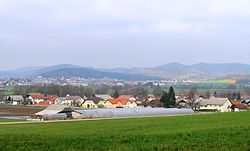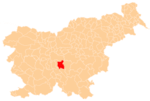Veliko Mlačevo
| Veliko Mlačevo | |
|---|---|
 | |
_location_map.svg.png) Veliko Mlačevo | |
| Coordinates: 45°56′23.28″N 14°40′38.8″E / 45.9398000°N 14.677444°ECoordinates: 45°56′23.28″N 14°40′38.8″E / 45.9398000°N 14.677444°E | |
| Country |
|
| Traditional region | Lower Carniola |
| Statistical region | Central Slovenia |
| Municipality | Grosuplje |
| Area | |
| • Total | 1.69 km2 (0.65 sq mi) |
| Elevation | 328.4 m (1,077.4 ft) |
| Population (2002) | |
| • Total | 438 |
| [1] | |
Veliko Mlačevo (German: Großmlatschevo)[2] is a village in the Municipality of Grosuplje in central Slovenia. It lies just southeast of Grosuplje itself in the historical region of Lower Carniola. The municipality is now included in the Central Slovenia Statistical Region.[3] The settlement includes the hamlet of Boštanj (German: Weißenstein)[2] south of the main settlement.
Name
The name Veliko Mlačevo literally means 'big Mlačevo', distinguishing it from the neighboring settlement of Malo Mlačevo (literally, 'little Mlačevo'). The name was first attested in 1277 as zemlassen (i.e., ze mlassen 'at Mlassen'), and in 1313 as in merern Maltscher (Mlatschen), in 1399 as zem grossen Mlatse, and in 1422 as an dem grossen Latschach, among other variations. The name is presumably derived from *Mlačevo selo/polje, ultimately meaning 'village/field belonging to Milač (or Mladič)'.[4] In the past the German name was variously Großmlatschevo,[2] Groß-Mlatschen,[5] Großmlatschou,[6] or Groß-Mlatschou.[7][8]
History
Prehistoric burial mounds and Roman graves have been discovered at Boštanj, above Veliko Mlačevo, attesting to early habitation of the area. Before the Second World War, the settlement had a population of 156 people living in 28 houses.[9] The Boštanj state-run farm was established after the Second World War and sold milk to Ljubljana. A brick works south of the settlement was abandoned in 1962, and a sawmill near Boštanj stopped operating in 1965.[10]
Castle
Boštanj Castle (Slovene: grad Boštanj, German: Weißenstein) stands on the foundations of a Roman fortification.[10] It was built up in the mid-16th century by Jacob von Lamberg. In 1678 ownership was assumed by the Ursini-Blagay family, who remained the owners until the beginning of the 20th century. It was a Renaissance castle designed like a fortress with a central rectangular building fortified with towers and a defensive wall.[11] The castle contained many late Gothic and Renaissance architectural elements, and also featured valuable Rococo and Classicist murals and ceiling paintings.[10] During the Second World War, after forcing besieged White Guard forces at the castle to withdraw to Turjak Castle,[12] the Partisans plundered and burned Boštanj Castle on 12 September 1943.[10][13] The castle burned for 14 days and the local fire department was forbidden from extinguishing the fire.[14]
-
Boštanj Castle ruins
-
Castle ruins, interior
-
Castle ruins, south wall
Church

The local church is dedicated to Saint Martin and belongs to the Parish of Žalna. In its core it is a 14th-century Gothic building that was heavily restyled in the Baroque in the 18th century.[15] The church was first mentioned in written sources in 1331. The church has an early Baroque high barrel-vaulted nave complemented by 18th-century altar furnishings. The main altar dates from 1716, and the wall paintings date from the end of the 17th century. A painting of Saint Anne on the north side altar is the work of Franc Jelovšek (1700–1764), the paintings on the south side altar are the work of Matija Koželj (1842–1917), and the Stations of the Cross are the work of the school of Leopold Layer (1752–1828).[10] The church is surrounded by a cemetery.
References
- ↑ Statistical Office of the Republic of Slovenia
- ↑ 2.0 2.1 2.2 Leksikon občin kraljestev in dežel zastopanih v državnem zboru, vol. 6: Kranjsko. 1906. Vienna: C. Kr. Dvorna in Državna Tiskarna, p. 112.
- ↑ Grosuplje municipal site
- ↑ Snoj, Marko. 2009. Etimološki slovar slovenskih zemljepisnih imen. Ljubljana: Modrijan and Založba ZRC, pp. 264–265.
- ↑ Intelligenzblatt zur Laibacher Zeitung, no. 141. 24 November 1849, p. 44.
- ↑ Intelligenzblatt zur Laibacher Zeitung, no. 100. 20 August 1829, p. 456.
- ↑ Vereinigte Laibacher Zeitung 1826, p. 1823.
- ↑ Rudolph, Heinrich. 1863. Vollständiges geographisch-topograhisch-statistisches Orts Lexikon.... Leipzig: Albert Hoffmann, p. 2887.
- ↑ Krajevni leksikon Dravske Banovine. 1937. Ljubljana: Zveza za tujski promet za Slovenijo, p. 345.
- ↑ 10.0 10.1 10.2 10.3 10.4 Savnik, Roman, ed. 1971. Krajevni leksikon Slovenije, vol. 2. Ljubljana: Državna založba Slovenije, p. 159.
- ↑ Cultural heritage information sign at Boštanj Castle.
- ↑ Saje, Franček. 1952. Belogardizem. Ljubljana: Slovenski knižni zavod, p. 592.
- ↑ Maček, Janko. 2011. "Usodna jesen 1943." Zaveza 80 (19 July) (Slovene)
- ↑ Zagradec pri Grosupljem Volunteer Fire Department (Slovene)
- ↑ "EŠD 2714". Registry of Immovable Cultural Heritage (in Slovene). Ministry of Culture of the Republic of Slovenia. Retrieved 29 June 2011.



